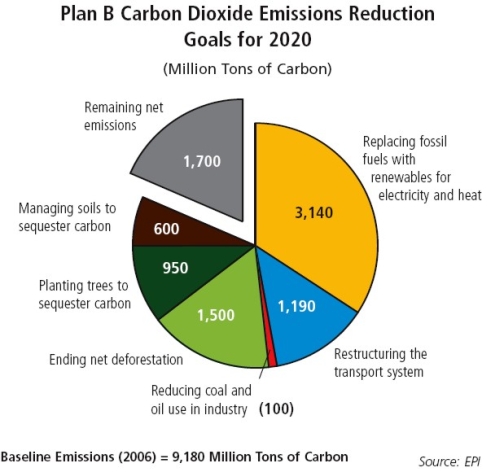A Look At Plan B, Version 3
Posted by Big Gav in carbon emissions, lester brown, plan b
Grist has a look at Lester Brown's latest version of Plan B.
Lester R. Brown, President of the Earth Policy Institute and author, most recently, of Plan B, Version 3.0: Mobilizing to Save Civilization, released a new study today called "Time for Plan B: Cutting carbon emissions by 80 percent by 2020." I was invited to participate in a conference call in which Lester explained many of the highlights of the plan; I will do my best to share what he said (any mistakes are my own).
First, it appears that the only comprehensive plan to cut emissions by 80 percent by 2020 is the one put out by Brown and his associates at the Earth Policy Institute. Partly this may be because Brown explicitly stated that he was not presenting what is politically feasible, but what is needed to cut emissions by 80 percent by 2020.
Cutting emissions by 80 percent by 2050, as he pointed out, is more politically comfortable because it means you don't have to do much now, but it is not what is needed. He discussed Jim Hansen's goal of getting CO2 emissions down to 350 parts per million, a goal which could be targeted after 2020, as the next step after reducing emissions by 80 percent.
Brown's plan consists of three main goals: raising efficiency, moving from fossil fuels to renewable energy, and biosequestration -- or basically, increasing the Earth's forest cover. Most of his talk focused on moving to renewables.
The core of the plan is to replace 40 percent of the world's electricity that is generated by coal -- there are currently about 2,400 coal-fired electricity generation plants in the world -- with wind power. This would mean, roughly, the construction of 1.5 million 2 MW wind turbines, which he said could be done over the next 12 years, using just the production capacity of idle U.S. auto factories. Although it seems like a huge amount of turbines, considering that the world produces 65 million automobiles a year, it's really quite doable.
Brown noted that Texas is aiming to supply 60 percent of residential electricity with the construction of huge wind complexes in that state. Brown travels quite a bit to China, and he says that the Chinese could supply twice the total electricity they now generate, which is currently mostly coal plants, with the enormous wind potential that they have. As for the U.S., he pointed out that Texas, Kansas, and North Dakota contain enough wind potential to replace all of our energy needs, much less electricity.
Solar energy has three main potentialities, according to Brown: solar water heaters (40 million of which have been installed in China alone), solar cells, and solar thermal plants (concentrating solar plants). He pointed out that Algeria wants to construct a 6,000 MW CSP plant in their desert; they plan to be a major of exporter of electricity, which will replace their oil exports when those run dry.






